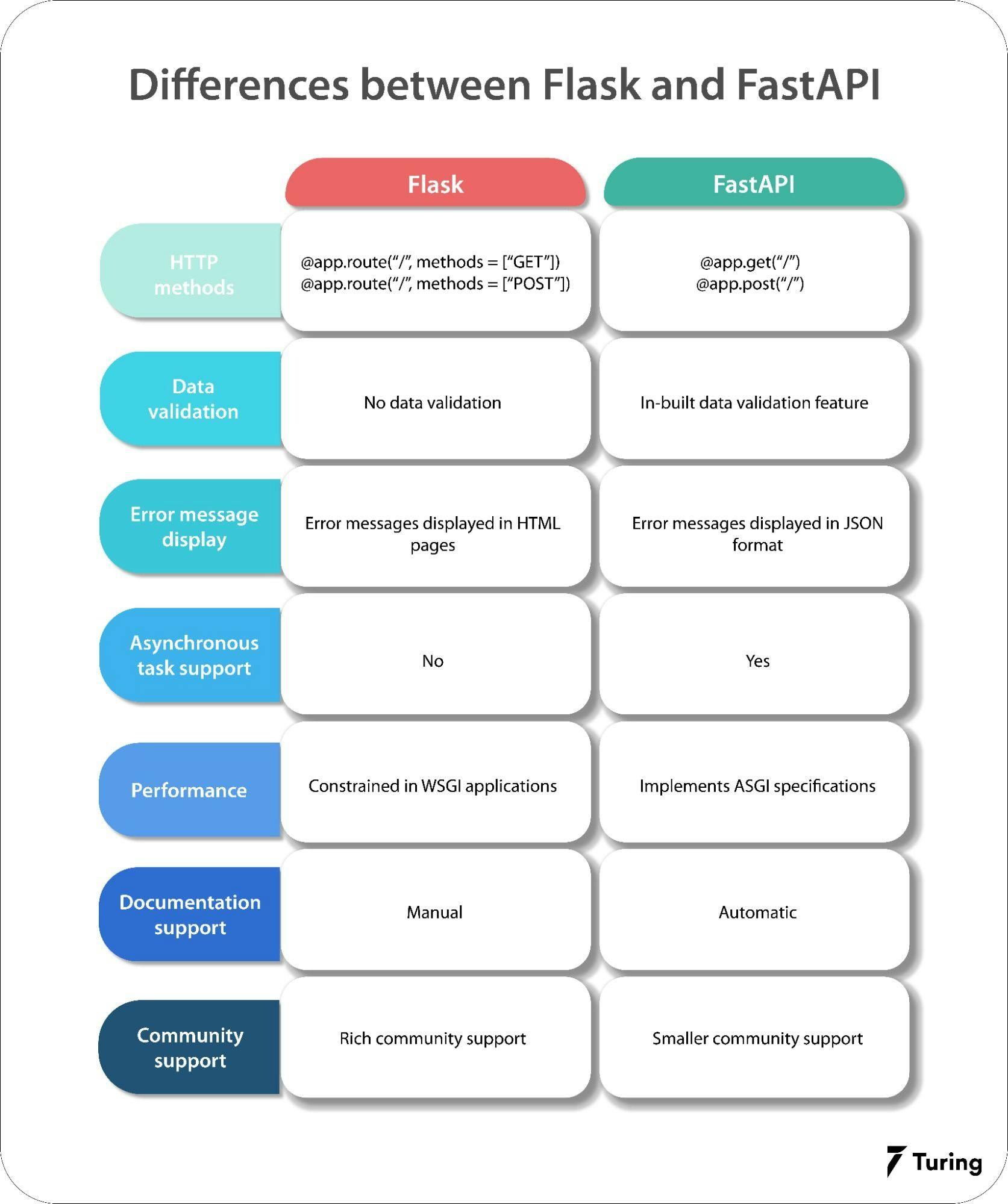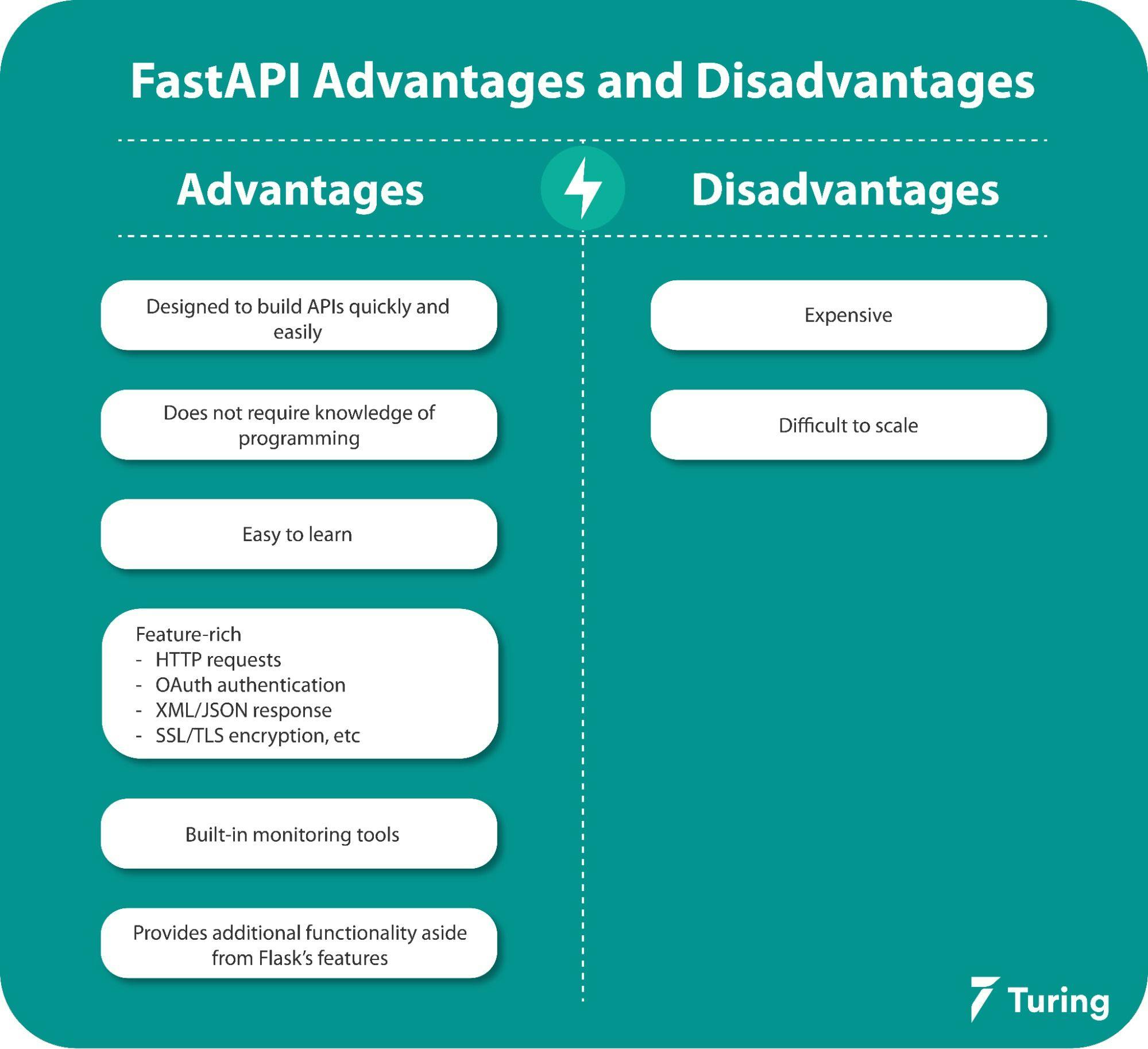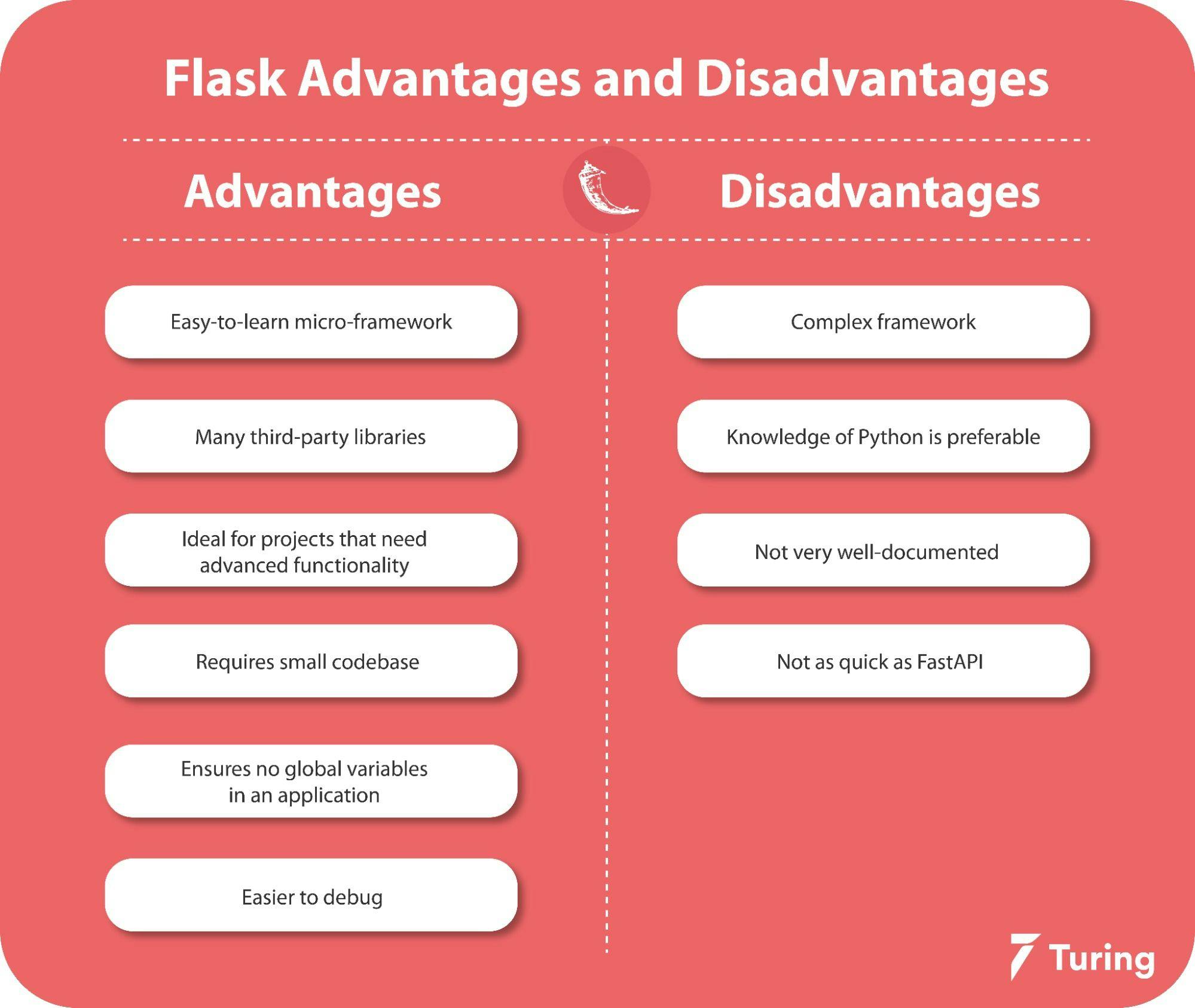Python FastAPI vs Flask: A Detailed Comparison
•10 min read
- Software comparisons

When you visit an e-commerce website and click on a button like ‘Place Order’, an HTTP request is sent to the backend. Here, a back-end server serves the request. This web server can be written in a JavaScript framework like NodeJS or with a Python framework like Flask. However, there is another framework called FastAPI that can be used. In this article, we’ll compare FastAPI vs Flask, including their features, differences, and pros and cons.
Python is a popular and widely used language among developers. Whether for machine learning (ML), deep learning, scripting, or application programming interface (API) development, it is by far the most favored. Companies continue to hire Python developers as they use the language to build their applications. Its popularity is largely in part due to the features and tools it offers like Flask, FastAPI, web-scraping, etc. Note that Flask is used by the majority of ML and API developers as it was released sooner, but FastAPI is quickly gaining popularity.
What is a web development framework?
Before exploring Flask and FastAPI, it’s important to have some knowledge of what a web development framework is.
A web development framework is used for developing web applications. It is a collection of modules, libraries, classes, and functions that helps web app developers write applications without having to think too much about low-level details like protocol and thread management.
Django, which is written in Python and developed by Django Software Foundation, is one of the best examples of web development frameworks. However, for small- and large-scale applications deployed on the cloud, the AWS Lambda function is used as an HTTP server with NodeJS.
What is Flask?
Flask is a Python-based lightweight Web Server Gateway Interface (WSGI) web application framework. It is the specification of a common interface between web servers and web applications.

Flask is also called a micro web framework because it does not require particular tools or libraries and aims to keep the core simple but extensible. It only provides the necessary components needed for development, such as routing, request handling, etc.
It is very easy to get started with the Flask application so it’s great for beginners too. It can be used for both simple and complex applications.
The Flask framework helps Flask developers build websites, FastAPI e-commerce stores, etc. It is also used to deploy machine learning models easily and conveniently. It is employed by leading companies like Netflix, Reddit, and Mozilla.
Features of Flask
- Provides development server and debugger.
- Light framework.
- Uses Jinja2 templates.
- Has extensions that help enhance its functionalities.
- Integrated support for unit testing.
- Neat API.
To install Flask in your system, use the command.
You can refer to Flask documentation here.
What is FastAPI?
Flask has been in use for ages and is one of the most famous Python frameworks for creating REST services. As discussed, it is easy to use and deploy and is effective for making microservices. However, Flask has a few disadvantages, so to compensate for them the FastAPI framework was born.

FastAPI is described as a modern and high-performance web framework for developing APIs with Python 3.6+. True to its name, FastAPI is fast. It offers high performance on par with NodeJS and GO. It is used by top companies like Uber and Netflix to build their applications.
To get started with FastAPI, you need to install FastAPI and Uvicorn using pip. Uvicorn is an Asynchronous Server Gateway Interface (ASGI) server used for production.
FastAPI has the advantage of handling requests asynchronously. All you need to do is to put the async keyword before a function when declaring endpoints. For example, async def my_endpoint():
Features of FastAPI
- Considered one of the fastest frameworks of Python.
- Documentation is simple, direct, and gives great editor support.
- Coding style helps reduce around 40% of induced bugs.
- Compatible with open standards for APIs and JSON schema.
- Interactive API documentation.
You can refer to FastAPI documentation here.
Now that we’ve briefly covered Flask and FastAPI together, let’s look at their differences.
Is FastAPI built on Flask?
Flask, which is a Python micro framework, is used for building FastAPI. It is a Python library that offers an easy way to create web applications with the help of HTML/CSS or Python. Unlike Flask, FastAPI doesn’t have a built-in development server, so an ASGI server similar to Daphne or Uvicorn is used when required. FastAPI’s speed is largely because ASGI is the server in which it was built and it supports asynchronous code.
WSGI and ASGI
WSGI is a Python standard specifically written for web applications and servers to interface with each other. It was introduced in 1999. Novice programmers can sometimes find it challenging to start with Python. However, those who have worked with PHP or Ruby will have an easier time understanding it.
ASGI was introduced by the inventors of FastAPI. It is a specification to build event-driven, asynchronous web applications. It comes with an API framework which means you can use any framework to build an application.
FastAPI and ASGI are complementary in the following ways:
- They allow you to have tools and libraries that make them easy to use.
- They allow you to write any code that is event-driven and asynchronous.
Python FastAPI vs Flask

Here are some important differences between FastAPI and Flask to help you understand them better.
HTTP methods
When you use Flask, the GET and POST commands are as follows:
When you use FastAPI, the commands are:
Passing parameters and data validation
No data validation is present in Flask. You can pass data of any type. For instance, if the input needed is an integer and you’ve given a string, tuple, or list, it will lead to a program crash. This validation in Flask needs to be handled explicitly by the developer.
However, FastAPI provides data validation as an inbuilt feature which makes things much easier. It allows developers to declare validation and extra information on the parameters they have.
Displaying error messages
In Flask, HTML pages are used to display error messages by default. With FastAPI, error messages are displayed in JSON format.
Asynchronous tasks
Flask doesn’t support asynchronous tasks. WSGI is used to deploy it. On the other hand, FastAPI ASGI supports asynchronous tasks.
FastAPI vs Flask performance
FastAPI does what it says. If you’re experienced with languages like NodeJS or Go, you will find that its performance is on par with them. Under the hood, FastAPI uses the asyncio library which allows Python developers to write concurrent code.
Asyncio is helpful for tasks that involve waiting for something, such as fetching data from APIs, querying a database, and reading the contents of a file. As mentioned, FastAPI implements ASGI specifications while Flask is constrained in a WSGI application.
Documentation support
In FastAPI, documentation is generated on the go when you build your API. This is very helpful. It generates a nice, clean user interface (UI) where you can test the API even when you have written no code for the UI.
To access these automated generated docs, you only need to hit the endpoint with /docs or /redoc and Swagger UI will be presented which allows you to test the API endpoints. It lists all the endpoints made in your application.
This is not the case with the Flask framework and is a disadvantage. Although Flask has documentation support, it can only be done manually.
Community support
Flask is an older framework and has extensive community support, whereas FastAPI's community is smaller. Sizable support is a big help when you’re stuck during development. Working with Flask means you will find answers to bugs you face, but you may struggle with it with FastAPI.
Pros and cons of FastAPI and Flask
It’s important to compare FastAPI vs Flask by exploring the pros and cons of both. This will help analyze the FastAPI vs Flask performance benchmark so you know which works best for you.

What are the pros of using FastAPI?
- FastAPI focuses on reliability, security, and simplicity. It is designed to build APIs easily and in no time. It doesn’t need any knowledge of programming which means that even non-programmers can use it.
- FastAPI provides many features, including HTTP requests, authentication using OAuth, XML/JSON responses, SSL/TLS encryption, etc. It is managed through a web interface that allows you to customize your account settings according to the API’s behavior.
- The built-in monitoring tools can be used to monitor API usage. It provides alerts when you reach any critical thresholds like response timestamp expirations and request count limits.
- The FastAPI framework is used to build APIs that depend on Flask. It is an extension of the web application framework that provides features you would expect from Flask but with additional functionality.
- FastAPI is recommended when you want to use a toolkit-based approach rather than building the whole application from scratch or using many boilerplate generators online. It borrows ideas from other libraries. This means that if you are familiar with other related libraries or frameworks, you will easily be able to learn and adapt to the FastAPI framework.
What are the cons of using FastAPI?
- The major disadvantage of the FastAPI framework is that it is expensive. This does vary according to the country you use it in and how many API calls you make each month. Overall, though, the cost is high.
- It can be difficult to scale your project. When you’re looking to scale from scratch to something bigger like an application or website, you will have trouble if your code is in PHP or uses MySQL or PostgreSQL. It is easier if you use FastAPI with Python, but this is not the framework of choice for long-term scalability.

What are the pros of using Flask?
- Flask, which is easy to learn and has many third-party libraries, is a good choice for projects that require advanced functionality. It needs a small codebase that is easier to understand too.
- Flask will ensure that you don’t have any global variables in your application as it gives every request its namespace. It helps you keep track of where objects belong. It also makes debugging easier and lets you find what you need when you’re writing code.
- Flask doesn’t limit the way you work with it. It does provide a list of tools that you can use for all your requirements; however, if you want to perform something other than what is already there, you can do so.
What are the cons of using Flask?
- The Flask framework is complex when compared to FastAPI. This can be a problem for those who don’t have the time to learn it, or for those who don’t have the necessary knowledge to perform certain functions. This also includes people who have not worked with Python in the past.
- Compared to FastAPI, Flask is less well-documented. There aren’t many guides that detail each of its features. This is a hindrance as every version comes with new features like private methods that give you more power over your application.
- The Flask framework is quick but not as quick as the FastAPI framework. This makes it a good choice when you want to build a small website that doesn’t need to be fast, but not for projects that require speed.
Usage differences
FastAPI is a full-stack framework that offers everything you need to build your API. On the other hand, Flask is a micro framework that doesn't provide all the features that FastAPI does. However, Flask is useful when you want to prototype an idea quickly or build a simple web application.
The major difference between FastAPI and Flask is in how they are used. While the Flask framework is for prototyping new applications and ideas, the FastAPI framework is for building APIs. It offers various options for building a backend server quickly without the need for coding experience.
For small-scale websites and web applications
FastAPI is easy to learn, is lightweight, and can be used to build small-scale websites and applications. It comes with an object-relational mapping (ORM) layer that handles data objects in the application so that you can access them quickly through coding.
The ORM layer helps keep track of all your databases so that you don’t need to worry about how to update them manually when new information is included, modified, or deleted in the website or application.
For machine learning models
FastAPI is used to build modern web APIs. It is built using Flask so you can use the code to create scalable and fast RESTful APIs and machine learning models.
It has many features that make it a great choice for ML models:
- Extensible plugins that allow you to add new features without having to alter the core code.
- Support for many libraries, including TensorFlow, Keras, and NiFi.
- Flexible architecture that allows you to easily customize your API and even build your modules from scratch.
When to use Flask?
- To develop web applications.
- To develop quick prototypes.
When to use FastAPI?
- To develop APIs from scratch.
- To lower the number of bugs and errors in code.
Which wins?
On the one hand, we have the very popular Flask framework and on the other, we have the FastAPI framework which has won the hearts of users, thanks to its many built-in functionalities. While both these Python frameworks are simple and easy to use, FastAPI has the edge as it compensates for Flask’s limitations.
FastAPI’s data validation feature is helpful when developing and debugging code that interacts with an API. The in-built documentation support listed with all the endpoints is the cherry on top. Its runtime performance is superior too. It also takes less time to write code, has fewer bugs, and has many more features, as we've discussed.
Based on these factors, adopting the FastAPI framework for your next REST project is the smart option. Of course, the choice is yours and depends on your use case but you might want to give FastAPI a try.

Author
Turing Staff